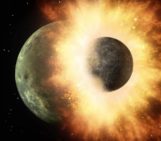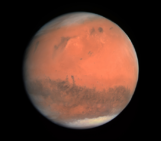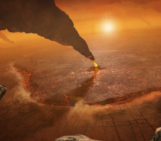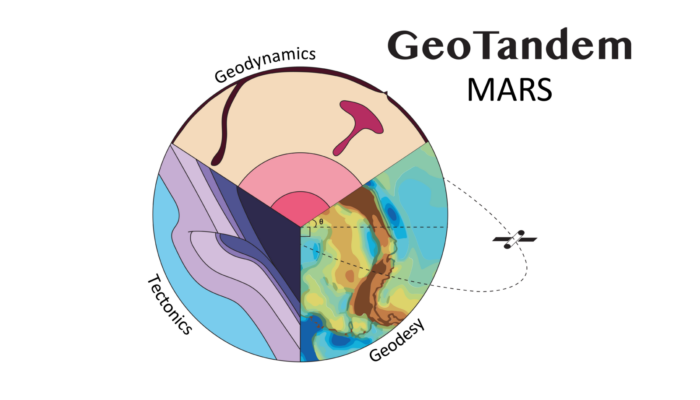
Welcome to the first of its kind, the Geotandem 01! A collaborative series between EGU divisions. Interdisciplinarity is intrinsic to Geosciences, so we want to showcase how researchers approach the same topics from different but also complementing perspectives. In each edition, we will bring you a high-interest topic for the community seen from the eyes of diverse disciplines. Today, the Tectonics & Structural, Geodesy and Geodynamics divisions come together to present one of our favorite planets of the solar system, Mars. How does a collaborative blog work? As simple as it sounds, after reading the first blog, you can access the blogs of the other two divisions by following these links:
(TS) Tectonics & Structural Geology of MARS by Hannah Davies
(G) Geodesy of MARS by Bart Root
Other topics that you’d like to see featured in the series? Let us know in the comments!
A geodynamic perspective of Mars is brought to you by Professor Scott King and recent PhD graduate Joshua Murphy from Virginia Tech Polytechnic Institute and State University.
Small planet: Mighty volcanoes
When we think about volcanoes on Mars, often the first thing that comes to mind is the immense shield volcano Olympus Mons, and maybe then the line of three smaller (but still immense) shields of the Tharsis Montes located to the southeast. These are all part of the vast volcanic province of Tharsis, frequently known as the Tharsis bulge or Tharsis rise, in reference to the basaltic plateau that constitutes this region, and on which the giant volcanoes are situated (Figure 1).
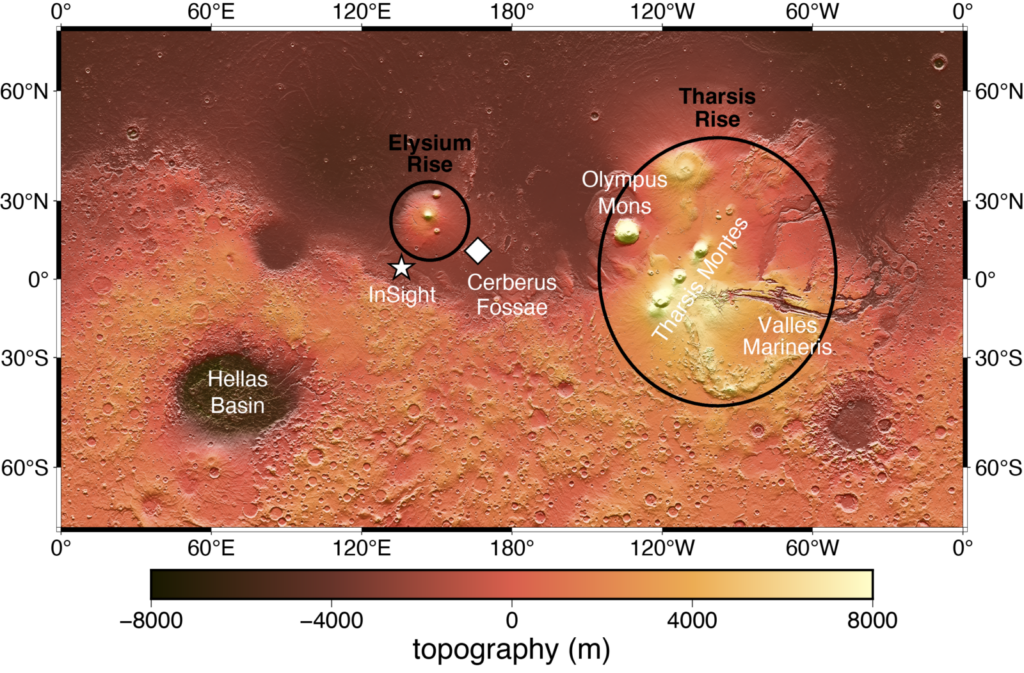
Figure 1: Locations of Tharsis and Elysium Rises (black circles) with additional landmarks. The InSight landing site is denoted with a white star and the Cerberus Fossae region is denoted with a white diamond. The underlying map is gridded topography from the NASA Mars Global Surveyor MOLA instrument. Topography is computed by taking the difference between the planetary radius and the areoid (credit: Scott King and Joshua Murphy)
Tharsis covers nearly a quarter of the Martian surface. At the northeastern edge of this region is another broad volcano (broader even, albeit shorter, than Olympus Mons), Alba Mons. While geographically associated with Tharsis, Alba Mons may well have a geodynamic origin separate from the rest of Tharsis. Yet, we should not forget about the Elysium volcanic province, also comprising a volcanic rise topped by large shield volcanoes. Though much smaller than Tharsis, the Elysium rise is still comparable in size to Earth’s largest igneous provinces, such as the Deccan traps, the Ontong-Java plateau, the Siberian traps and the Paraná traps (Figure 2). Even less apparent, if brought more into the foreground by the recent NASA’s InSight mission, is the extent of volcanic activity beyond the rise itself. To the south of the rise lies the volcanic plain Elysium planitia (where InSight landed) and, on the eastern side of Elysium planitia, the grabens of Cerberus Fossae, a region where many of the marsquakes detected by InSight originated (Stähler et al., 2022).
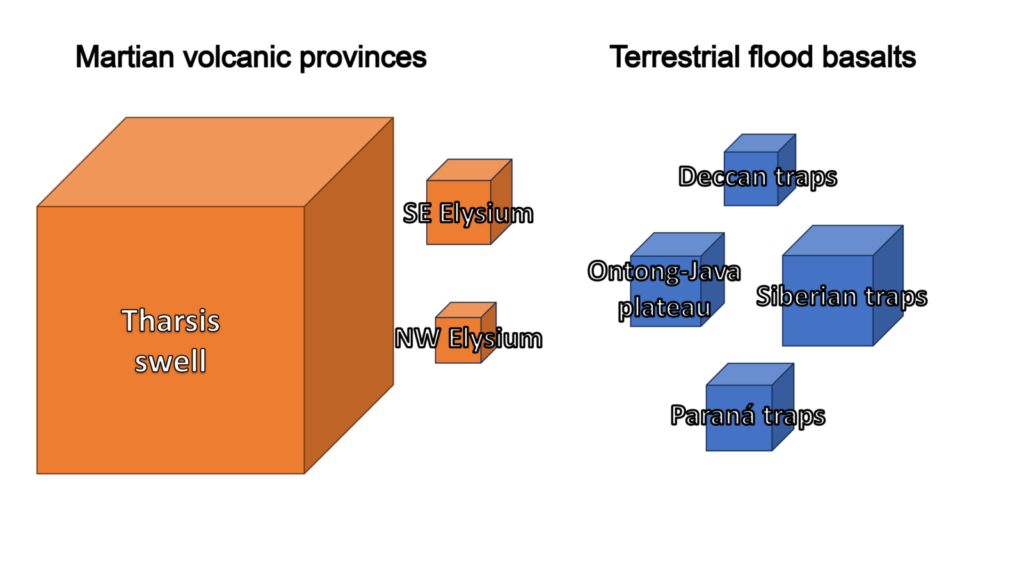
Figure 2: volume of martian and terrestrial Large Igneous Provinces (LIP) shown as relative sized cubes (credit Scott King and Joshua Murphy)
How can such a small planet as Mars with a relatively cool interior (…) still produce melt after nearly 4.6 Gyr?
Squeezing magma out of a small cool planet
One might also ask how can such a small planet as Mars with a relatively cool interior (as confirmed by InSight) still produce melt after nearly 4.6 Gyr. In our work, we address this question by using geodynamics models to constrain mean temperatures profiles of the Martian mantle (Figure 3, Murphy and King, 2023). These results show that the small amount of geologically recent volcanism can only be explained by very limited and localized mantle melting.This leaves us with a conundrum: either Mars managed to extract magma from the mantle much more efficiently that typical midocean ridges, or our the Martian interior is hotter or more volatile rich than current thinking.
either Mars managed to extract magma from the mantle much more efficiently that typical midocean ridges, or our the Martian interior is hotter or more volatile rich than current thinking
To be sure, there are other volcanoes and volcanic regions on Mars, such as Syrtis Major. But what sets Tharsis and Elysium apart, besides their sizes, is the time span of volcanic activity. The Tharsis rise itself was emplaced by around 3.7 Ga, with the Elysium rise being of roughly similar age. This era of voluminous basaltic volcanism was followed by the construction of the major shield volcanoes, and dwindling, intermittent activity well into the past hundred million years or so. There are lava flows on Olympus Mons dated to as recently as 2.4 Ma (Neukum et al., 2004). (Though the reader is cautioned that Mars ages are subject to much more uncertainty than terrestrial ages, as they are based on how cratered exposed surfaces are, using lunar surface ages and impact rates calibrated by radiometric dating of lunar samples and then extrapolated to Mars.) Volcanic activity in the Elysium rise itself ended sooner, with a steep decline after ~1 Ga (Susko et al., 2017; Platz et al., 2010). But activity continued in Elysium Planitia, with pulses of activity identified by (Voucher et al., 2009) from 2.5-234 Ma, and in Cerberus Fossae as recently 0.05-0.2 Ma (Hovarth et al., 2021). In geologic terms, this is practically yesterday.
Tharsis and the crustal dichotomy: a connection remains elusive
As it so happened, Elysium Planitia was selected as the landing site for InSight—not primarily for its geologic or geophysical interest, but because the plains offered a safe location to land a mission targeted toward the study of an entire planet. As it also turned out, this left Tharsis very far from InSight, and mostly within the seismic shadow zone created by Mars’ molten core, where only relatively powerful marsquakes could be picked up and located by InSight. Two of the largest marsquakes (magnitude > 4) have been traced to this shadow zone, but neither were in Tharsis. Yet, fortuitously, the choice of landing site also left InSight in close proximity to Cerberus Fossae, which not only possesses some of the youngest lava flows on Mars, but maintains a surprisingly high level of seismic activity, further bolstering the idea that Mars, and the greater Elysium region in particular, remains geodynamically active. Indeed, this evidence is consistent with an active mantle plume under the Elysium region (Broquet and Andrews-Hanna; 2022).
Concluding thoughts
While we have learned much about the interior of Mars from the InSight mission: the crust beneath InSight is somewhat thinner than expected and it comprised of two or three internal layers (Knapmeyer-Endrun et al., 2021); the core is molten and may be larger than expected (Irving et al., 2023) although this is currently debated (Khan et al., 2023; Samuel et al., 2023); the strong, cold outer shell, the lithosphere, is almost 500 kilometers thick, and the mantle is cool, compared with Earth’s mantle (Huang et al., 2022). Integrating the volcanic history with the InSight observations will reveal even more about the interior of the red planet.
References: Broquet, A., and Andrews-Hanna, J. C. (2022). Geophysical evidence for an active mantle plume underneath Elysium Planitia on Mars. Nature Astronomy, 7, 160-169. https://doi.org/10.1038/s41550-022-01836-3 Harder, H., Christensen, U. A one-plume model of martian mantle convection. Nature 380, 507–509 (1996). https://doi.org/10.1038/380507a0 Horvath, D. G., Moitra, P., Hamilton, C. W., Craddock, R. A. and Andrews-Hanna, J. C. (2021). Evidence for geologically recent explosive volcanism in Elysium Planitia, Mars. Icarus, 365. https://doi.org/10.1016/j.icarus.2021.114499 Huang, Q., Schmerr, N. C., King, S. D., Kim, D., Rivoldini, A., Plesa, A.-C., Samuel, H., Maguire, R. R., Karakostas, F., Lekić, V., et al. Seismic detection of a deep mantle discontinuity within Mars by InSight. Proc. Natl. Acad. Sci. U.S.A., 119(42), 2022. doi:https://doi.org/10.1073/. Kiefer, W.S. and Li, Q. (2016), Water undersaturated mantle plume volcanism on present-day Mars. Meteorit Planet Sci, 51: 1993-2010. https://doi.org/10.1111/maps.12720 Knapmeyer-Endrun, B., Panning, M. P., Bissig, F., Joshi, R., Khan, A., Kim, D., et al. (2021). Thickness and structure of the Martian crust from InSight seismic data. Science, 373(6553), 438–443. https://doi.org/10.1126/science.abf8966 Khan, A., Huang, D., Durán, C. et al. Evidence for a liquid silicate layer atop the Martian core. Nature 622, 718–723 (2023). https://doi.org/10.1038/s41586-023-06586-4 Murphy, J. P. and King, S. D. Reconciling Mars InSight Results, Geoid, and Melt Evolution with 3D Spherical Models of Convection. Authorea. December 14, 2023. DOI: 10.22541/au.170259033.32492301/v1 Neukum, G., Jaumann, R., Hoffmann, H., Hauber, E., Head, J. W., Basilevsky, A. T., Ivanov, B. A., Werner, S. C., van Gasselt, S., Murray, J. B., and the HRSC Investigator Team. (2004). Recent and episodic volcanic and glacial activity on Mars revealed by the High Resolution Stereo Camera. Nature, 432, 971–979. https://doi.org/10.1038/nature03231 Platz, T., Michael, G. G., and Neukum, G. (2010). Confident thickness estimates for planetary surface deposits from concealed crater populations. Earth and Planetary Science Letters, 293, 388–395. https://doi.org/10.1016/j.epsl.2010.03.012 Samuel, H., Drilleau, M., Rivoldini, A., Xu, Z., Huang, Q., Garcia, R. F., Lekić, V., Irving, J. C. E., Badro, J., Lognonné,, P. H., et al. (2023). Geophysical evidence for an enriched molten silicate layer above Mars’s core. Nature, 622, 712-717. https://doi.org/10.1038/ Smrekar, S. E., Lognonné, P., Spohn, T., Banerdt, W.B., Breuer, D., et al. (2019). Pre-mission InSights on the Interior of Mars. Space Science Reviews, 215(1), 1-72. https://doi.org/10.1007/s11214-018-0563-9 Stähler, S. C., Mittelholz, A., Perrin, C., Kawamura, T. Kim, D., Knapmeyer, M., Zenhäusern, G., Clinton, J., Giardini, D., Lognonné, P., and Banerdt, W. B.. (2022). Tectonics of Cerberus Fossae unveiled by marsquakes. Nature Astronomy, 6, 1376–1386. https://doi.org/10.1038/s41550-022-01803-y Susko, D., Karunatillake, S., Kodikara, G., Skok, J .R., Wray, J., Heldmann, J., Cousin, A., and Judas, T. (2017). A record of igneous evolution in Elysium, a major martian volcanic province. Scientific Reports 7, 43177. https://doi.org/10.1038/srep43177 Vaucher, J., Baratoux, D., Mangold, N., Pinet, P., Kurita, K., and Grégoire, M. (2009). The volcanic history of central Elysium Planitia: Implications for martian magmatism. Icarus, 204(2), 418–442. https://doi.org/10.1016/j.icarus.2009.06.032



